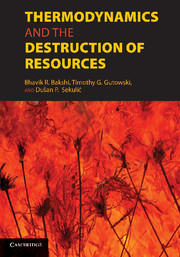Book contents
- Frontmatter
- Contents
- Contributor List
- Foreword by Herman E. Daly
- Foreword by Jan Szargut
- Preface
- Introduction
- PART I FOUNDATIONS
- PART II PRODUCTS AND PROCESSES
- PART III LIFE-CYCLE ASSESSMENTS AND METRICS
- 9 Using Thermodynamics and Statistics to Improve the Quality of Life-Cycle Inventory Data
- 10 Developing Sustainable Technology: Metrics From Thermodynamics
- 11 Entropy Production and Resource Consumption in Life-Cycle Assessments
- 12 Exergy and Material Flow in Industrial and Ecological Systems
- 13 Synthesis of Material Flow Analysis and Input–Output Analysis
- PART IV ECONOMIC SYSTEMS, SOCIAL SYSTEMS, INDUSTRIAL SYSTEMS, AND ECOSYSTEMS
- Appendix: Standard Chemical Exergy
- Index
- References
9 - Using Thermodynamics and Statistics to Improve the Quality of Life-Cycle Inventory Data
Published online by Cambridge University Press: 01 June 2011
- Frontmatter
- Contents
- Contributor List
- Foreword by Herman E. Daly
- Foreword by Jan Szargut
- Preface
- Introduction
- PART I FOUNDATIONS
- PART II PRODUCTS AND PROCESSES
- PART III LIFE-CYCLE ASSESSMENTS AND METRICS
- 9 Using Thermodynamics and Statistics to Improve the Quality of Life-Cycle Inventory Data
- 10 Developing Sustainable Technology: Metrics From Thermodynamics
- 11 Entropy Production and Resource Consumption in Life-Cycle Assessments
- 12 Exergy and Material Flow in Industrial and Ecological Systems
- 13 Synthesis of Material Flow Analysis and Input–Output Analysis
- PART IV ECONOMIC SYSTEMS, SOCIAL SYSTEMS, INDUSTRIAL SYSTEMS, AND ECOSYSTEMS
- Appendix: Standard Chemical Exergy
- Index
- References
Summary
Introduction
Methods that consider the life cycle of alternative products are popular for evaluating their environmental aspects. Such methods, including life cycle assessment (LCA), net energy analysis, and exergetic LCA, rely on life-cycle inventory (LCI) data. These data are usually compiled from various sources, including industrial measurements, government databases, and fundamental knowledge, and include information about resource use and emissions. The reliability of the results of these assessment methods depends largely on the quality of the inventory data. Like all measured data, LCI data are also subject to various kinds of errors. The need for addressing uncertainty in LCA has been identified over the years by many researchers, and several papers have discussed their characteristics and sources. The types of uncertainties include those that are due to data inaccuracy, data gaps, model uncertainty, spatial and temporal variability, and mistakes [1–3]. Many methods have been explored for understanding the effect of such uncertainties, as summarized recently in [3, 4]. The nature and extent of uncertainties in LCA is such that formal methods for dealing with all of them are truly challenging to find.
This chapter focuses on reducing data uncertainty in the LCI. Such uncertainty is due to process variability and failures such as instrument malfunction, poor sampling, or mistranscription of data. In general, these errors may be divided into two categories: random and gross errors. Random errors are uncorrelated and Gaussian, whereas gross errors are non-Gaussian and include outliers.
- Type
- Chapter
- Information
- Thermodynamics and the Destruction of Resources , pp. 235 - 248Publisher: Cambridge University PressPrint publication year: 2011



